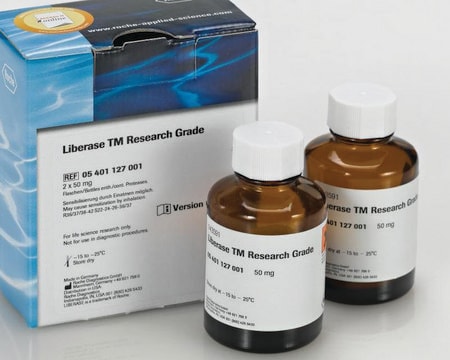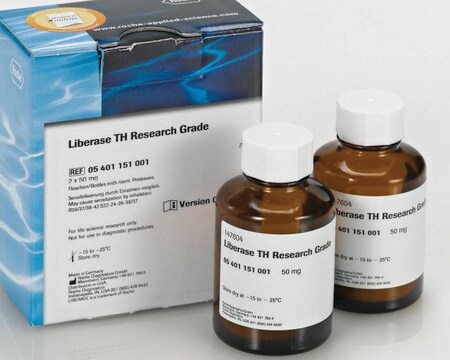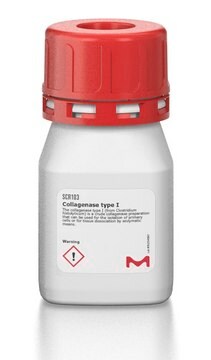추천 제품
생물학적 소스
enzyme from Bacillus polymyxa (Protease)
enzyme from Clostridium histolyticum (collagenase)
Quality Level
설명
high Dispase concentration
양식
lyophilized
포장
pkg of 10 mg (05401054001 [2 x 5 mg])
pkg of 100 mg (05401089001 [2 x 50 mg])
제조업체/상표
Roche
파라미터
35-37 °C optimum reaction temp.
기술
activity assay: suitable
색상
white
최적 pH
7.4
solubility
water: soluble
응용 분야
life science and biopharma
외래 활성
Endotoxin 3 EU/mg
배송 상태
dry ice
저장 온도
−20°C
일반 설명
Liberase enzyme technology comprises methods for purifying clostridial collagenase isoforms to high specific activity, and for blending them together with high-specific-activity neutral protease in optimal ratios for effective dissociation of primary tissues and cultured cells. Liberase DH Research Grade contains highly purified Collagenase I and Collagenase II. These two collagenase isoforms are blended in a precise ratio to each other, and with a high concentration of Dispase®, a non-clostridial neutral protease.
Liberase enzymes are designed to increase the quality and reproducibility of tissue dissociation, and improve the viability and functionality of isolated cells. Liberase Purified Enzyme Blends replace traditional collagenase, which is a crude and variable fermentation by-product of Clostridium histolyticum.
애플리케이션
It has been used for the digestion of metastatic tumor fragments. It has been used for the enzymatic detachment of human embryonic stem cells colonies.
특징 및 장점
- Maximize viability and yield of isolated cells
- Count on higher specific activity of the enzyme blend
- Obtain higher experimental reproducibility
제조 메모
Working concentration: Liberase Research Grade Enzyme Working Concentration
Liberase enzymes have significantly higher specific activities than traditional collagenases. This means that the working concentration of Liberase Research Grade Purified Enzymes, expressed in mg/ml, will be lower than that of traditional collagenase.
When the application is on the Roche list of applications at www.collagenase.com, use the Liberase Research Grade concentration recommended for that application.
When the application is not included on this list, first use Liberase TM Research Grade at a concentration of 0.08–0.28 Wünsch units/ml.
The goal is to determine the best starting concentration of Liberase Research Grade Enzyme Blends. This is a starting point, and the final concentration may vary due to differences in procedure and lot-to-lot differences in traditional collagenase.
Collagenase Working Concentration
Multiply your previous collagenase working concentration (mg/ml) by its specific activity (Wünsch units/mg, [as determined above]), to obtain Wünsch units/ml. To determine how much Liberase Research Grade Enzyme Blend to use, first multiply your collagenase working concentration (in Wünsch units/ml) times the total volume of your working enzyme solution to obtain the total collagenase activity needed (Wünsch units). Divide the total collagenase activity required by the Liberase Research Grade stock concentration ( “Reconstitution and Storage”). This indicates how many milliliters of Liberase Research Grade Enzyme Blend stock solution to use in your working enzyme solution.
Storage conditions (working solution): Store unused stock solution in single-use aliquots at -15 to -25 °C. For further information on product stability, please visit the Roche Liberase Enzyme website at www.collagenase.com.
Note: Avoid repeated freezing and thawing!
재구성
Reconstitute the entire vial. Do not weigh individual aliquots of the lyophilizate. The introduction of moisture into the vial results in a decline in enzymatic activity.
Place vial on ice to rehydrate the lyophilized enzyme.
Gently agitate the vial at 2 to 8 °C until the enzyme is completely dissolved (max. 30 min).
Depending on the type of tissue-dissociation buffer used to dissolve Liberase Research Grade Purified Enzyme Blends, slight precipitations may be observed which readily dissolve in the diluted working solution, and have no influence on enzyme activity.
Remove an aliquot of the stock solution to prepare the working solution.
Reconstitution volume
2 ml (1 vial with 5 mg–10 mg pack size)
10 ml (1 vial with 50 mg–100 mg pack size)
Collagenase Wünsch (units/ml)
13 (1 vial with 5 mg–10 mg pack size)
26 (1 vial with 50 mg–100 mg pack size)
Total Collagenase concentration [mg/ml]
2.5 (1 vial with 5 mg–10 mg pack size)
5.0 (1 vial with 50 mg–100 mg pack size)
저장 및 안정성
기타 정보
- This product is intended for life science research and in vitro use only. These products are not to be used for diagnostic or clinical applications, such as human islet transplantation.
- All 1st generation Liberase and Liberase Blendzyme products (Liberase HI, CI, RI, PI, Liberase Blendzyme 1, 2, 3, 4) have been replaced by the 2nd generation Liberase Research Grade and Liberase GMP grade enzyme blend portfolios. For instructions concerning the transition from previously used Liberase Enzymes
For life science research only. Not for use in diagnostic procedures.
법적 정보
신호어
Danger
유해 및 위험 성명서
Hazard Classifications
Eye Irrit. 2 - Resp. Sens. 1 - Skin Irrit. 2
Storage Class Code
11 - Combustible Solids
WGK
WGK 1
Flash Point (°F)
does not flash
Flash Point (°C)
does not flash
이미 열람한 고객
문서
Enzyme Explorer Key Resource: Collagenase Guide.Collagenases, enzymes that break down the native collagen that holds animal tissues together, are made by a variety of microorganisms and by many different animal cells.
관련 콘텐츠
Collagenase Guide.Collagenases, enzymes that break down the native collagen that holds animal tissues together, are made by a variety of microorganisms and by many different animal cells.
자사의 과학자팀은 생명 과학, 재료 과학, 화학 합성, 크로마토그래피, 분석 및 기타 많은 영역을 포함한 모든 과학 분야에 경험이 있습니다..
고객지원팀으로 연락바랍니다.









